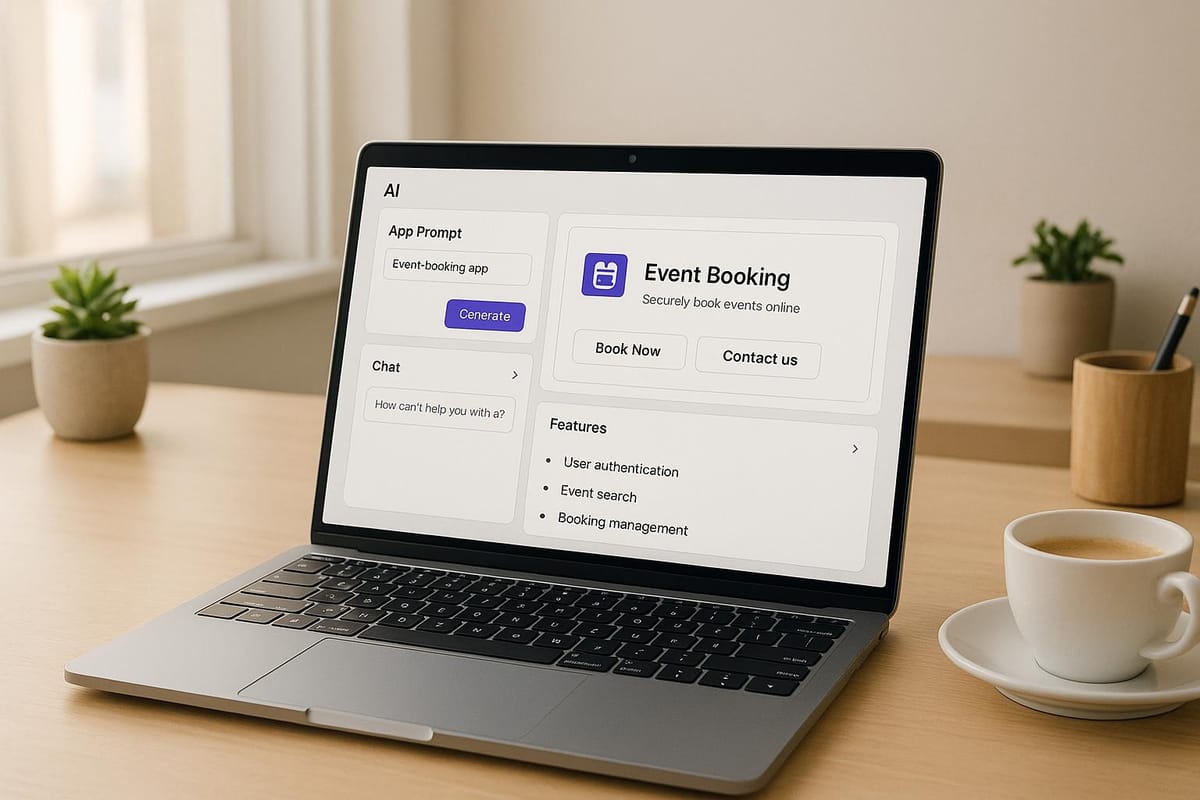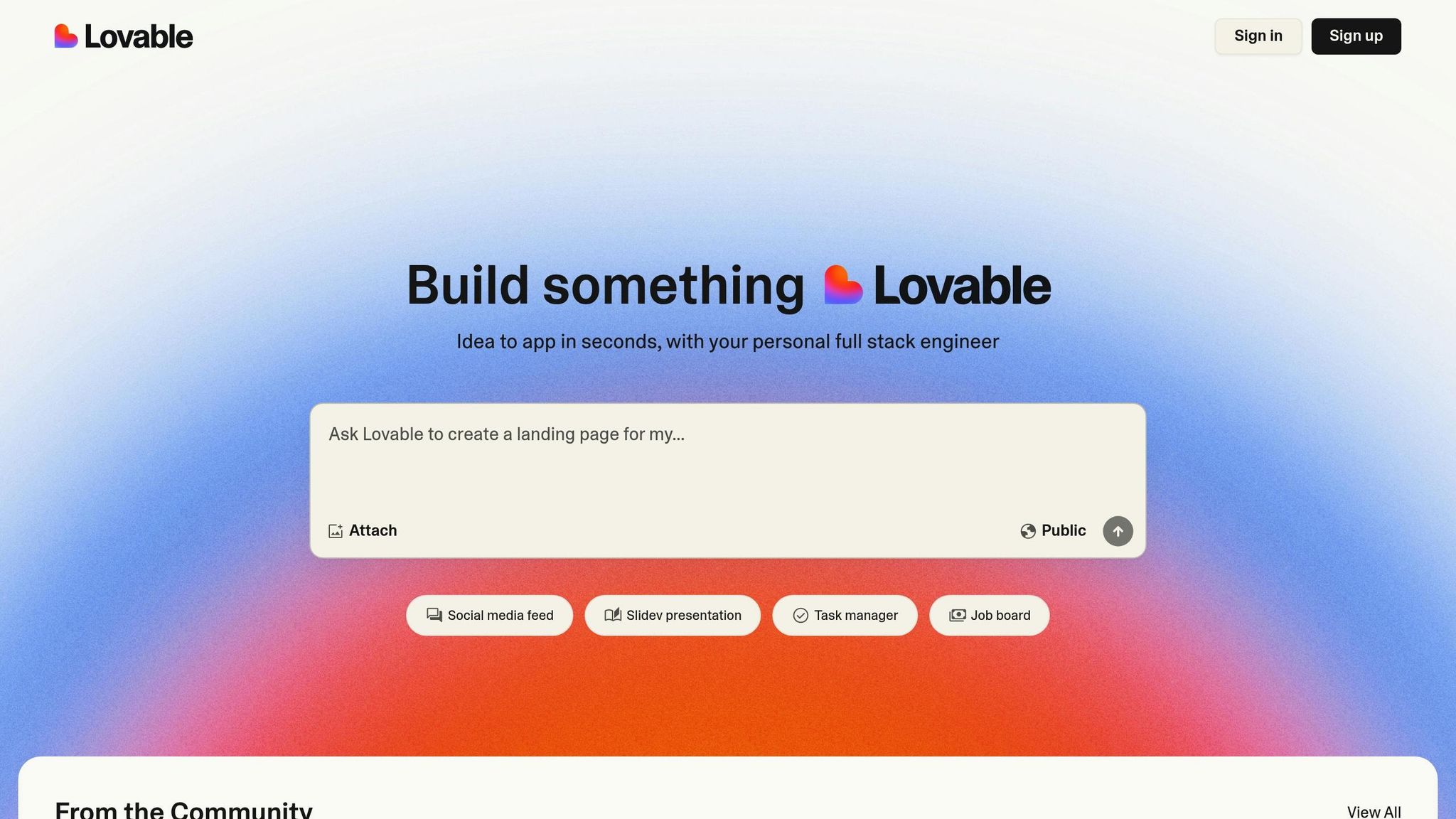Beginner's Guide to Loveable.dev App Prompts
Learn how to craft effective prompts for app development with AI to streamline your app-building process and enhance functionality.

Loveable.dev makes app building simple for everyone, even if you don't know how to code. The secret? Writing clear prompts that guide the AI to create exactly what you need. Here’s what you need to know:
- What are prompts? They’re instructions for the AI to build app features, design interfaces, or connect external tools.
- What makes a good prompt? Be specific, consistent, and provide enough context. For example, instead of "Build a user system", say, "Create a user authentication system with email verification and password reset."
- Common prompt types:
- Feature Generation: Build core app functions like user logins.
- Interface Design: Create dashboards or layouts.
- Data Structure: Define how data is stored (e.g., customer profiles).
- Integration: Link external tools like APIs.
- Tips for success:
- Start with simple prompts and build gradually.
- Break complex tasks into smaller steps.
- Test and refine prompts for better results.
Want to create apps faster and easier? Focus on writing clear and detailed prompts to get the most out of Loveable.dev.
Prompt Basics for Loveable.dev

What Makes a Prompt
A prompt tells the AI what app components to create. To be effective, a prompt needs three key parts:
- Intent: Clearly state what you want to build.
- Context: Include background details and requirements.
- Parameters: Add specific details to guide the output.
These elements help the AI deliver the desired functionality. For example, when creating a recruitment platform like Sherlock, prompts should outline features like managing candidate pipelines or integrating AI-driven assessments.
Different Prompt Categories
Loveable.dev supports various prompt types, each designed for a specific aspect of app development:
| Prompt Type | Purpose | Example Use |
|---|---|---|
| Feature Generation | Builds core functionality | User authentication system |
| Interface Design | Creates UI components | Dashboard layout |
| Data Structure | Defines data models | Customer profile schema |
| Integration | Links external services | API endpoint setup |
These prompts work together to shape how the AI performs, which will be explored further in the next section.
How Prompts Affect Results
The way you craft a prompt has a direct impact on the AI's output. Clear and precise prompts allow tools like the Code Clone and Similarity Analysis Platform to implement features and visualizations effectively.
Three elements make a prompt effective:
- Specificity: The more detailed the prompt, the better the results.
- Consistency: Use consistent terminology across related prompts.
- Context: Provide enough background to guide the AI.
Each prompt builds on the ones before it, creating a smooth development process. This means that getting the early prompts right is essential for achieving success in later stages.
Chapter 4: Designing Lovable Coding Prompts | Lovable.dev Course
Writing Better Prompts
Building on the basics of prompt creation, here are some advanced techniques to sharpen your approach. The foundation of a strong prompt lies in being clear and detailed.
Clear Writing Tips
To create effective prompts, focus on clarity and precision. Start with a clear objective that outlines what your app should do. For example:
Create an AI writing assistant with:
- Real-time grammar correction
- Style improvement suggestions
- Tone analysis capabilities
- Text summarization feature
Avoid vague language. Instead of saying, "Build a user system", be specific: "Create a user authentication system with email verification, password reset, and profile management."
This level of detail ensures your instructions are actionable and easy to follow.
Including Key Details
When describing your app's requirements, include these critical elements:
| Detail Category | What to Include | Example |
|---|---|---|
| User Interface | Layout preferences, design needs | "Design a mobile-first dashboard with dark mode support" |
| Data Handling | Data types and storage requirements | "Store user habits with daily timestamps and encryption" |
| Feature Scope | Core functionalities and integrations | "Include daily habit tracking functionality" |
| Performance | Speed and optimization expectations | "Ensure dashboard loads within 2 seconds" |
These details help ensure your vision is clearly communicated and understood.
Setting Boundaries
Defining boundaries is just as important as specifying features. Here’s how you can set clear limits:
-
Technical Constraints: Outline platform capabilities and performance expectations, such as:
- Maximum number of concurrent users
- Data storage limits
- API call frequency caps
-
Feature Parameters: Clearly define the scope of each feature:
- Milestone triggers
- Types of badges or rewards
- Conditions for unlocking features
-
User Experience Limits: Specify interaction boundaries to guide user behavior:
- Limit the number of process steps
- Set timeframes for automated actions
- Restrict user input where necessary
Fixing Common Problems
Crafting clear and focused prompts is essential when using Loveable.dev. Many common issues can be resolved by improving clarity and precision.
Unclear Instructions
| Poor Prompt | Improved Prompt | Why It Works |
|---|---|---|
| "Make an app" | "Create a task management app with user authentication, project boards, and deadline tracking" | Clearly outlines required features |
| "Add AI features" | "Implement AI-powered text analysis for sentiment scoring (0-100) and keyword extraction" | Specifies the desired AI functionality |
| "Need user system" | "Design a user system with email verification, password reset, and profile customization including avatar uploads" | Breaks down the components needed for the user system |
Next, let’s tackle the issue of overly detailed prompts.
Too Much Information
Providing too much detail in a prompt can overwhelm the AI and lead to confusion. Instead, break it into phases or prioritize key elements.
Phase Breakdown Example:
Phase 1: Core Features
- User authentication
- Basic profile management
- Task creation and editing
Phase 2: Advanced Features
- Team collaboration
- File attachments
- Activity tracking
Focus on Key Requirements:
Primary Requirements:
- Content editor with formatting options
- Media upload capability
- Version control system
Optional Features:
- Advanced SEO tools
- Multi-language support
- Analytics dashboard
By separating essentials from extras, you make it easier for the AI to focus on what's most important.
Prompt Troubleshooting
If your prompts don't deliver the desired results, follow these steps to refine them:
- Review Outputs: Look at the results and pinpoint any issues or unclear areas.
- Refine Key Parameters:
- Clearly define the scope of the task
- Specify features in detail
- Highlight technical constraints
- Include user interface requirements where relevant
- Test Iteratively: Make small adjustments to the prompt and document the results.
| Step | Action | Expected Outcome |
|---|---|---|
| Initial Review | Analyze the current output | Identify where the prompt falls short |
| Scope Analysis | Ensure the requirements are realistic | Adjust the scope if necessary |
| Clarity Check | Confirm all instructions are specific | Remove any vague language |
| Test Changes | Modify one aspect at a time | Monitor and track improvements |
Examples and Tips
Here are some practical examples and advice to help you apply prompt troubleshooting strategies effectively.
Building an App Step-by-Step
Let's say you're creating a debt management app.
Initial Setup Prompt:
Develop a debt management platform with:
- A user dashboard for tracking debts
- A system for monitoring debt balances
- Payment scheduling features
- Tools for visualizing progress
- Secure data storage capabilities
Feature Implementation Prompt:
Add financial features such as:
- A debt consolidation calculator
- Payment history tracking
- Options for custom payment plans
- Interest rate comparison tools
- Integration with monthly budgeting systems
User Experience Prompt:
Focus on designing an intuitive interface by:
- Using a clean and simple layout
- Ensuring mobile responsiveness
- Including one-click payment scheduling
- Displaying visual progress charts
- Providing real-time notifications
Success Stories
Take Sherlock, an AI-powered recruitment OS, as an example. Developed by Lovable.dev in collaboration with partners like Claude and Supabase, Sherlock has significantly streamlined hiring workflows. In fact, it has saved recruiters over 136 workdays annually.
Tips for New Users
- Start Simple: Focus on building the core functionality first.
- Iterate Gradually: Break complex features into smaller, easier-to-handle prompts.
- Test Thoroughly: Ensure current features work as expected before adding new ones.
Next Steps
Now that you've explored the strategies above, here's how to take your prompt writing skills to the next level.
Key Focus Areas
To excel at prompt writing, concentrate on three things: core functionality, clear and precise language, and breaking down complex tasks. These principles will help you craft prompts that are both effective and easy to implement.
Getting Started
Dive into these helpful resources from LoveableApps.ai to start practicing:
-
Tutorial: Building a Todo App
This step-by-step guide walks you through creating a simple app with authentication features. It's perfect for learning the basics of prompt writing and app structure. -
Mastering Loveable.dev Course
A 24-lesson course that covers everything from foundational concepts to creating production-ready apps. It puts a strong emphasis on writing prompts for a variety of use cases. -
API Documentation
A detailed reference guide featuring real-world examples, schemas, and an interactive playground. It’s an excellent tool for learning how to structure prompts for different API endpoints.
These resources will help you refine your skills and build confidence by:
- Exploring successful projects created by others
- Connecting with experienced developers for tips and insights
- Finding inspiration for your own applications
- Accessing in-depth tutorials and guides tailored to your needs
Use these tools to practice and perfect the techniques outlined in this guide!
FAQs
How can I simplify complex app development tasks by breaking them into smaller prompts on Loveable.dev?
To simplify complex app development tasks on Loveable.dev, start by identifying the main goal of your app and breaking it into smaller, manageable steps. Each step can be turned into a specific AI prompt, guiding the app-building process more effectively.
For example, if you're building a task management app, you could break it into prompts like creating a user login system, designing a task input interface, or generating a calendar view. By focusing on one feature at a time, you can streamline development and ensure each part works seamlessly before moving to the next.
This approach not only makes the process less overwhelming but also allows you to experiment and refine individual components. The Loveable.dev platform is designed to support this iterative, prompt-driven workflow, making it perfect for indie makers and small teams.
What are common mistakes to avoid when creating prompts in Loveable.dev, and how can I fix them?
When creating prompts in Loveable.dev, a few common mistakes can hinder your app's performance. Overly vague prompts often lead to unclear or irrelevant AI responses, so aim for specificity and clarity. Additionally, overloading prompts with unnecessary details can confuse the AI and dilute the intended outcome - keep your instructions concise and focused. Lastly, avoid failing to test prompts iteratively, as this can result in unexpected behavior or suboptimal results.
To troubleshoot, start by reviewing your prompt for clarity and simplicity. Break down complex instructions into smaller, more manageable steps. Test your prompts frequently, tweaking them based on the AI's responses, and experiment with phrasing to find what works best. Remember, iterative refinement is key to crafting effective prompts in Loveable.dev.
How can I use prompts in Loveable.dev to connect with external tools like APIs, and what should I include for seamless integration?
Prompts in Loveable.dev can be tailored to work with external tools like APIs by ensuring they provide clear and structured instructions for the AI to process. To achieve seamless integration, include specific API endpoints, the required parameters, and any authentication details (e.g., API keys). This ensures the AI can interact effectively with the external service.
Additionally, test your prompts thoroughly to confirm they handle various responses from the API, including errors, and adjust them as needed to improve reliability. A well-structured prompt is key to building robust connections between Loveable.dev apps and external tools.



